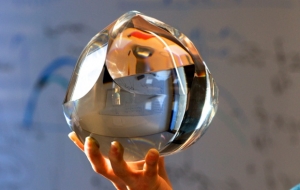Advances in quantum cryptography mean that we can protect our secrets even when our communications are being spied on or we are using devices built by our enemies, according to an Oxford University researcher.
Revelations of the extent of government surveillance have thrown a spotlight on the insecurity of our digital communications. Even today's encrypted data is vulnerable to technological progress. Writing in this week's Nature, Professor Artur Ekert of Oxford University and the National University of Singapore, and co-author Renato Renner of ETH Zurich, explore what physics tells us about keeping our secrets secret.In the history of secret communication, the efforts of code-makers have been matched time and again by the ingenuity of code-breakers. It is already believed that one of today's most widely used encryption systems, RSA, will become insecure once a quantum computer is built. But that story need not go on forever.
'Recent developments in quantum cryptography show that privacy is possible under stunningly weak assumptions about the freedom of action we have and the trustworthiness of the devices we use,' says Professor Ekert of Oxford University's Mathematical Institute, who is also Director of the Centre for Quantum Technologies at the National University of Singapore.
Over 20 years ago, Professor Ekert and others independently proposed a way to use the quantum properties of particles of light to share a secret key for secure communication. The key is a random sequence of 1s and 0s, derived by making random choices about how to measure the particles (and some other steps), that is used to encrypt the message. In the Nature Perspective, Ekert and Renner describe how quantum cryptography has since progressed to commercial prospect and into new theoretical territory.
Even though privacy is about randomness and trust, the most surprising recent finding is that we can communicate secretly even if we have very little trust in our cryptographic devices – imagine that you buy them from your enemy – and in our own abilities to make free choices – imagine that your enemy is also manipulating you. Given access to certain types of correlations (form the quantum world or elsewhere), and having a little bit of free will, we can protect ourselves. We can even protect ourselves against adversaries with superior technology that is unknown to us.
'As long as some of our choices are not completely predictable and therefore beyond the powers that be, we can keep our secrets secret,' says Renner, Professor of Theoretical Physics at ETH Zurich, Switzerland. This arises from a mathematical discovery by Renner and his collaborator about 'randomness amplification': they found that a quantum trick can turn some types of slightly-random numbers into completely random numbers. Applied in cryptography, such methods can reinstate our abilities to make perfectly random choices and guarantee security even if we are partially manipulated.
'As well as there being exciting scientific developments in the past few years, the topic of cryptography has very much come out of the shadows. It's not just spooks talking about this stuff now,' says Ekert.
The authors conclude: 'The days we stop worrying about untrustworthy or incompetent providers of cryptographic services may not be that far away'.
The Perspective article, entitled ‘The ultimate physical limits of privacy', is published in this week's Nature



 Arguably mathematicians are the scientific all-rounders, applying their
skills to a range of subjects from chemistry and medicine to engineering and
economics. In some cases these skills extend even further. Professor Alain
Goriely, Statutory Professor of Mathematical Modelling in Oxford, has just won
second prize in the Weird and Wonderful section of the 2014
National Science Photography Competition, organised by the Engineering and
Physical Sciences Research Council (EPSRC) for his photograph of a gömböc. A gömböc is a convex
Arguably mathematicians are the scientific all-rounders, applying their
skills to a range of subjects from chemistry and medicine to engineering and
economics. In some cases these skills extend even further. Professor Alain
Goriely, Statutory Professor of Mathematical Modelling in Oxford, has just won
second prize in the Weird and Wonderful section of the 2014
National Science Photography Competition, organised by the Engineering and
Physical Sciences Research Council (EPSRC) for his photograph of a gömböc. A gömböc is a convex